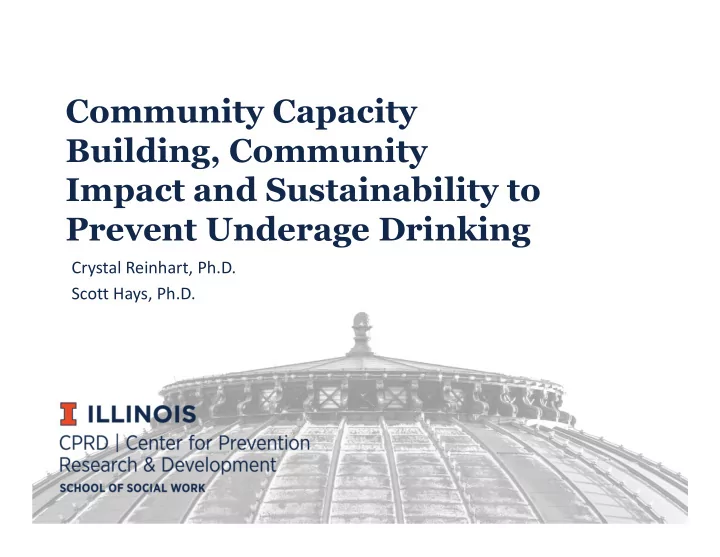

Community Capacity Building, Community Impact and Sustainability to Prevent Underage Drinking Crystal Reinhart, Ph.D. Scott Hays, Ph.D.
Agenda and Goals 1) Present information about the Illinois SPF‐PFS Project 2) Discuss capacity building in 9 Illinois SPF‐funded communities 3) Present information about the overall impact on Illinois communities 4) Discuss sustainability efforts
What is SPF-PFS? • Strategic Prevention Framework‐Partnerships For Success • SAMHSA‐CSAP funded project to address underage drinking (ages 12‐17) and prescription drug misuse (ages 12‐25) in high‐risk communities using the Strategic Prevention Framework (SPF) • History of SPF grants including the SPF‐SIG in 2006‐ 2010 and PFS in 2011‐2015 • The SPF‐PFS in Illinois was funded in 2015, along with 12 states, D.C., 6 tribal areas and 3 U.S. territories
Strategic Prevention Framework Five step strategic planning process: 1) Assessment 2) Capacity 3) Planning 4) Implementation 5) Evaluation Sustainability and Cultural Competence
Illinois SPF-PFS Project • Five year project from 2015‐2019 through the Illinois Department of Human Services • 9 sub‐recipient communities • Chosen based on 4 factors: 1) High need 2) Limited resources 3) Capacity 4) Geographic distribution
Sub-Recipient Process: Capacity • Each sub‐recipient hired a full‐time project coordinator • Initial training for the grant included: – Training on federal and state reporting requirements – Orientation to the prevention field in Illinois – Overview of Strategic Planning (online webinar) – Coalition development and coordination – Other optional trainings
Partnerships For Success • Each sub‐recipient community formed a community coalition. • Coalitions met at least quarterly throughout the project • Coalition Sectors: – 3 required – 9 others • Reported members, meeting dates, and notes in online portal
Sub-Recipient Process: Assessment 1) Community Profile 2) Resource Assessment 3) Consumption Patterns 4) Consequences 5) Contributing Factor Prioritization 6) Summary of the Problem 7) Stakeholder Readiness Assessment 8) Target Population Profile
Illinois Youth Survey • School‐based youth survey conducted every other year (even years) • 8th, 10th, and 12th grade students • Conducted since 1994 • Voluntary for schools to participate, but no cost • Topics include drug use and perceptions, bullying, violence, school climate, nutrition, and other health and social indicators
Discussion Question: How do you track student level/youth substance use data in your state? Do you track data at the community level? What tools do you use?
Sub-Recipient Process: Planning • Setting goals and objectives (SMART) • Selecting strategies that fit the community – Capacity, barriers, and feasibility – Evidence-based standards • Building capacity to implement strategies – Human and organizational – Community support – Financial capacity – Cultural competency
Sub-Recipient Process: Planning Contributing Factors Easy Easy Permissive Low Strategy Retail Social Social Perceived Access Access Norms Risk Youth Prevention Education X X Compliance Checks X Shoulder Tap Operations X Party Prevention and X Controlled Dispersal Sobriety Checkpoints X Communication Campaign X X X
Sub-Recipient Process: Implementation • Individual strategy training • Strategies implemented: – Communication campaign targeting youth – Communication campaign targeting parents – Youth prevention education – Compliance checks – Party prevention/controlled party dispersal
Sub-Recipient Process: Evaluation • Annual Strategy Reviews – Compared report to evidence‐based standards • Tracking IYS data over time – 2014 to 2018 data – Focused on increasing survey participation in funded communities
Sustainability and Cultural Competence Cultural Competence • Health Disparity Plans and Data Tracking • Started in June 2018 Sustainability • Sustainability Plans developed with coalition • Started in December 2018
What Actually Happened in Illinois?
Timeline Issues
What Actually Happened in Illinois? • Sub‐Recipient Agency Troubles – Two agencies closed during the 5 year grant – Rural sub‐recipient’s that experienced turnover had a lot of difficulty filling the positions – Staff turnover throughout the grant caused training gaps • Health Disparities and Sustainability – Many felt this was brought into the grant too late – Federal requirements and reporting for HD started in 2018 – Sustainability plans in early 2019
What Actually Happened in Illinois? Change in Past 30 Day Alcohol Use State vs. SPF‐PFS 28.9% 2014 31.0% Statewide SPF Schools 26.0% 2018 21.0%
What does the future hold for Illinois communities? • Applications for New Funding – Drug Free Communities – New community‐based SPF funding from SAMHSA – Private foundations – Local grants • Strategies – Taken on by schools/other agencies – Moving on with new funding – Discontinuing • Coalitions – Changing focus to new substances – Discontinuing
Discussion Question: How many substance-related coalitions should exist in a community? Should coalitions focus on youth, adults, or both? Should coalitions only focus on one substance?
Questions? Crystal Reinhart, Ph.D. Center for Prevention Research and Development University of Illinois at Urbana‐Champaign Email: reinhrt@Illinois.edu
Recommend
More recommend